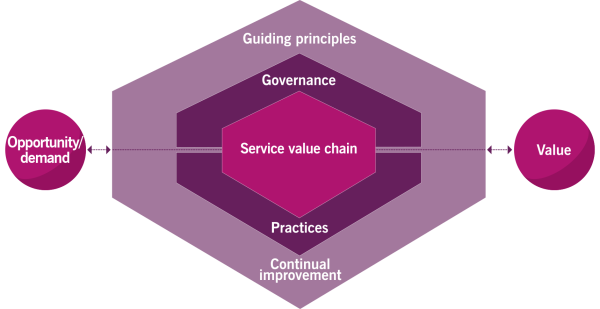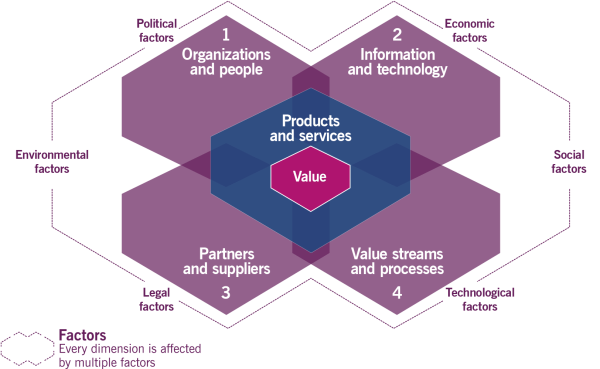ITIL is the most widely used global best practice framework for the management of IT and digitally enabled products and services.
Why ITIL?
ITIL has been undergoing improvements over the years, with the first publication in the 90s focusing on standardising IT practices. This was to create standards for IT systems that would make service delivery more efficient. The latest ITIL 4 version is more value-oriented, which explains why ITIL could be valuable for many organisations.
The ITIL processes address various aspects of IT service management including risk management, service management cost, customer relations, service strategy, and more.
What are the benefits of using ITIL Processes?
The ITIL framework continues to support organisations and individuals to gain optimal value from IT and digital services. It equips a service provider with a clear capability model, aligning them to the business strategy and customer needs.
The main benefits of the framework are:
- ITIL helps businesses navigate the new technological era. The Fourth Industrial Revolution is marked by emerging technology in fields including robotics, artificial intelligence, nanotechnology, quantum computing, biotechnology, the Internet of Things (IoT), 3D printing, autonomous vehicles and much more.
- ITIL provides a practical and flexible basis to support organisations on their journey into the new world of digital transformation by helping them align their human, digital and physical resources to compete within the modern complex landscape.
- The context of ITIL has an emphasis on the business and technology world and how it works in the future with Agile, DevOps and digital transformation.
- ITIL is much more relevant to software developers, service management practitioners and businesses through promoting a holistic view of delivering products and services.
- ITIL emphasises the importance of collaboration, transparency, automating.
- Change is a constant state and organisations are struggling to navigate it. ITIL is the best practice that supports organisations in navigating this ongoing change.
- ITIL supports faster quality and value-driven delivery for people and organisations.
The ITIL framework consists of key components like the ITIL Service Value System (SVS) and the four dimensions model.
ITIL Service Value System (SVS)
The ITIL Service Value System (SVS) represents how the various components and activities of the organisation work together to enable value creation. These can be combined in a flexible way, which requires integration and coordination to keep the organisation consistent.
The ITIL SVS facilitates this integration and coordination and provides a strong, unified, value-focused direction for the organisation.
The core components of the ITIL SVS are:

The ITIL Service Value Chain provides an operating model for the creation, delivery, and continual improvement of services. It is a flexible model that defines six key activities that can be combined in many ways, forming multiple value streams.
The ITIL Service Value Chain is flexible enough to be adapted to multiple approaches, including DevOps and centralised IT, to address the need for multimodal service management. The adaptability of the ITIL Service Value Chain enables organisations to react to changing demands from their stakeholders in the most effective and efficient ways.
The flexibility of the ITIL Service Value Chain is further enhanced by the ITIL practices. Each ITIL practice supports multiple service value chain activities, providing a comprehensive and versatile toolset for ITSM practitioners.
ITIL Framework: The Four Dimensions Model
To ensure a holistic approach to service management, the ITIL framework outlines four dimensions of service management, from which each component of the ITIL SVS should be considered.
The four dimensions are:
- Organisations and People
- Information and Technology
- Partners and Suppliers
- Value Streams and Processes

By giving each of the four dimensions an appropriate amount of focus, an organisation ensures that ITIL SVS remains balanced and effective.
ITIL Certification Path
The ITIL certification scheme offers comprehensive, practical and proven guidance for establishing a service management system, providing a common glossary of terms for businesses leveraging IT-enabled services.
After achieving the ITIL Foundation certification, which delivers a basic understanding of the framework, professionals can advance and specialise further on their ITIL path. To explore all available certification levels and learn how to personalise your ITIL journey, visit our ITIL certification page.
How to get ITIL certified
In order to obtain your ITIL Certification you need to follow a course with an AXELOS’ Accredited Training Organisations (ATOs). QRP International is an official ATO for ITIL, accredited by Peoplecert on behalf of Axelos.
QRP International is authorised to deliver ITIL Foundation and other ITIL courses.
See everything explained in our quick ITIL YouTube Video!
Would you like support in order to figure out the best solution for you and your team? We would be happy to provide more info on the different IT Service Management methods available – contact us!
Source: PeopleCert
Copyright © PeopleCert group 2022. Reproduced under license from PeopleCert. All rights reserved.










